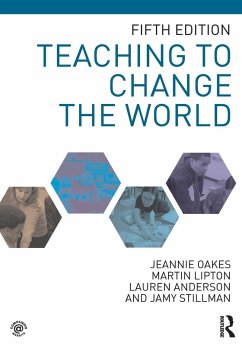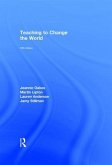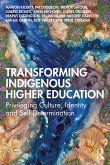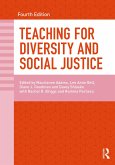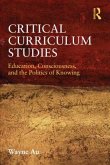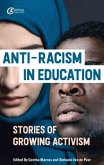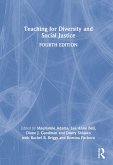Jeannie Oakes (University of California, Los Angeles, USA), Martin Lipton (University of California, Los Angeles, USA), Lauren Anderson (USA Connecticut College)
Teaching to Change the World
Jeannie Oakes (University of California, Los Angeles, USA), Martin Lipton (University of California, Los Angeles, USA), Lauren Anderson (USA Connecticut College)
Teaching to Change the World
- Broschiertes Buch
- Merkliste
- Auf die Merkliste
- Bewerten Bewerten
- Teilen
- Produkt teilen
- Produkterinnerung
- Produkterinnerung
Teaching to Change the World is an up-to-the-moment, engaging, social-justice oriented introduction to education and teaching, and the challenges and opportunities they present.
Andere Kunden interessierten sich auch für
![Teaching to Change the World Teaching to Change the World]() Jeannie OakesTeaching to Change the World193,99 €
Jeannie OakesTeaching to Change the World193,99 €![A Critical Introduction to Mathematics Education A Critical Introduction to Mathematics Education]() Mark WolfmeyerA Critical Introduction to Mathematics Education41,99 €
Mark WolfmeyerA Critical Introduction to Mathematics Education41,99 €![Transforming Indigenous Higher Education Transforming Indigenous Higher Education]() Marion KickettTransforming Indigenous Higher Education39,99 €
Marion KickettTransforming Indigenous Higher Education39,99 €![Teaching for Diversity and Social Justice Teaching for Diversity and Social Justice]() Teaching for Diversity and Social Justice64,99 €
Teaching for Diversity and Social Justice64,99 €![Critical Curriculum Studies Critical Curriculum Studies]() Wayne Au (University of Washington, Bothell, USA)Critical Curriculum Studies53,99 €
Wayne Au (University of Washington, Bothell, USA)Critical Curriculum Studies53,99 €![Anti-racism in Education Anti-racism in Education]() Anti-racism in Education29,99 €
Anti-racism in Education29,99 €![Teaching for Diversity and Social Justice Teaching for Diversity and Social Justice]() Teaching for Diversity and Social Justice156,99 €
Teaching for Diversity and Social Justice156,99 €-
-
-
Teaching to Change the World is an up-to-the-moment, engaging, social-justice oriented introduction to education and teaching, and the challenges and opportunities they present.
Produktdetails
- Produktdetails
- Verlag: Taylor & Francis Ltd
- 5 ed
- Seitenzahl: 534
- Erscheinungstermin: 9. Februar 2018
- Englisch
- Abmessung: 254mm x 178mm x 29mm
- Gewicht: 966g
- ISBN-13: 9781138569362
- ISBN-10: 1138569364
- Artikelnr.: 51118506
- Herstellerkennzeichnung
- Libri GmbH
- Europaallee 1
- 36244 Bad Hersfeld
- gpsr@libri.de
- Verlag: Taylor & Francis Ltd
- 5 ed
- Seitenzahl: 534
- Erscheinungstermin: 9. Februar 2018
- Englisch
- Abmessung: 254mm x 178mm x 29mm
- Gewicht: 966g
- ISBN-13: 9781138569362
- ISBN-10: 1138569364
- Artikelnr.: 51118506
- Herstellerkennzeichnung
- Libri GmbH
- Europaallee 1
- 36244 Bad Hersfeld
- gpsr@libri.de
Jeannie Oakes is Presidential Professor (Emeritus) in Educational Equity at UCLA's Graduate School of Education and Information Studies and founding director of UCLA's Center X: Where Research and Practice Intersect for Urban School Professionals. Martin Lipton is an education writer and consultant, a communications analyst at UCLA's Institute for Democracy, Education, and Access, and a former public high school teacher. Lauren Anderson is an associate professor of education at Connecticut College and a former upper-elementary teacher. Jamy Stillman is an associate professor of educational equity and cultural diversity at the University of Colorado Boulder and a former bilingual elementary teacher.
List of Figures, Concept Tables, and Focal Points Preface Acknowledgments
Part I: Democracy, Diversity, and Inequity 1. The U.S. Schooling Dilemma:
Diversity, Inequity, and Democratic Values 2. History and Culture: How
Expanding Expectations and Powerful Ideologies Shape Schooling in the
United States 3. Politics and Philosophy: The Struggle over the School
Curriculum 4. Policy and Law: Rules That Schools Live By Part II: The
Practice of Teaching to Change the World 5. The Subject Matters:
Constructing Knowledge Across the Content Areas 6. Instruction: Teaching
and Learning Across the Content Areas 7. Assessment: Measuring What Matters
8. Classrooms as Communities: Developing Caring and Democratic
Relationships Part III: The Context of Teaching to Change the World 9. The
School Culture: Where Good Teaching Makes Sense 10. School Structure:
Sorting Students and Opportunities to Learn 11. The Community: Engaging
with Families and Neighborhoods 12. Teaching to Change the World: A
Profession and a Hopeful Struggle Bibliography Index
Part I: Democracy, Diversity, and Inequity 1. The U.S. Schooling Dilemma:
Diversity, Inequity, and Democratic Values 2. History and Culture: How
Expanding Expectations and Powerful Ideologies Shape Schooling in the
United States 3. Politics and Philosophy: The Struggle over the School
Curriculum 4. Policy and Law: Rules That Schools Live By Part II: The
Practice of Teaching to Change the World 5. The Subject Matters:
Constructing Knowledge Across the Content Areas 6. Instruction: Teaching
and Learning Across the Content Areas 7. Assessment: Measuring What Matters
8. Classrooms as Communities: Developing Caring and Democratic
Relationships Part III: The Context of Teaching to Change the World 9. The
School Culture: Where Good Teaching Makes Sense 10. School Structure:
Sorting Students and Opportunities to Learn 11. The Community: Engaging
with Families and Neighborhoods 12. Teaching to Change the World: A
Profession and a Hopeful Struggle Bibliography Index
List of Figures, Concept Tables, and Focal Points Preface Acknowledgments
Part I: Democracy, Diversity, and Inequity 1. The U.S. Schooling Dilemma:
Diversity, Inequity, and Democratic Values 2. History and Culture: How
Expanding Expectations and Powerful Ideologies Shape Schooling in the
United States 3. Politics and Philosophy: The Struggle over the School
Curriculum 4. Policy and Law: Rules That Schools Live By Part II: The
Practice of Teaching to Change the World 5. The Subject Matters:
Constructing Knowledge Across the Content Areas 6. Instruction: Teaching
and Learning Across the Content Areas 7. Assessment: Measuring What Matters
8. Classrooms as Communities: Developing Caring and Democratic
Relationships Part III: The Context of Teaching to Change the World 9. The
School Culture: Where Good Teaching Makes Sense 10. School Structure:
Sorting Students and Opportunities to Learn 11. The Community: Engaging
with Families and Neighborhoods 12. Teaching to Change the World: A
Profession and a Hopeful Struggle Bibliography Index
Part I: Democracy, Diversity, and Inequity 1. The U.S. Schooling Dilemma:
Diversity, Inequity, and Democratic Values 2. History and Culture: How
Expanding Expectations and Powerful Ideologies Shape Schooling in the
United States 3. Politics and Philosophy: The Struggle over the School
Curriculum 4. Policy and Law: Rules That Schools Live By Part II: The
Practice of Teaching to Change the World 5. The Subject Matters:
Constructing Knowledge Across the Content Areas 6. Instruction: Teaching
and Learning Across the Content Areas 7. Assessment: Measuring What Matters
8. Classrooms as Communities: Developing Caring and Democratic
Relationships Part III: The Context of Teaching to Change the World 9. The
School Culture: Where Good Teaching Makes Sense 10. School Structure:
Sorting Students and Opportunities to Learn 11. The Community: Engaging
with Families and Neighborhoods 12. Teaching to Change the World: A
Profession and a Hopeful Struggle Bibliography Index

